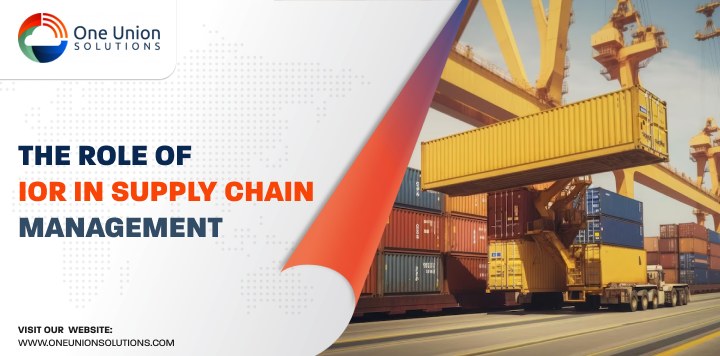Understanding the Nexus: The Role of IOR in Supply Chain Management
Optimizing operational efficiency while satisfying customer requests is critical in the intricate ecology of supply chain management. The key component of this optimization is the Input-Output Ratio (IOR), a basic statistic that controls how resources are used in supply chain activities. The importance of IOR in improving supply chain efficiency and simplifying logistics is explored in detail in this article. Throughout the supply chain, IOR is essential for promoting efficiency. Organizations may increase customer satisfaction and save costs by identifying inefficiencies and streamlining processes by carefully analyzing input-output ratios. Resource-demand alignment, or IOR, guarantees smooth supply chain operations. As a result of this alignment, the supply chain is more flexible and customer-focused and can respond quickly to customer demands while reducing delays and interruptions.
Unveiling the Significance of IOR in Global Supply Chains
Within the complex network of international supply chains, the (IOR) is a crucial factor in determining both cost-effectiveness and operational efficiency. IOR, is a concept in supply chain management that represents the delicate balancing act between input resources and output deliverables, enabling firms to fulfill the demands of a global marketplace while still optimizing their operations.
Navigating the intricacies of international commerce, varied regulatory frameworks, and shifting customer preferences call for a comprehensive knowledge of IOR in the context of global supply chain dynamics. Businesses may reduce waste, optimize their logistics processes, and improve the effectiveness of their supply chains by proactively managing IOR. It is impossible to overestimate the importance of IOR in logistics as it directly affects important areas including order fulfillment, efficient transportation, and inventory management. By carefully considering IOR balancing, organizations may satisfy customer expectations and gain a competitive edge in the global market by achieving timely deliveries, shorter lead times, and appropriate inventory levels.
IOR’s Impact on Smooth Supply Chain Operations
Driving Efficiency: IOR’s Impact on Smooth Supply Chain Operations
In the field of supply chain management, attaining operational excellence requires efficiency. An important factor in promoting efficiency throughout supply chain processes is the input-output ratio or IOR. Through a rigorous examination of the correlation between input resources and output deliverables, entities may pinpoint opportunities for enhancement and optimization procedures. IOR optimization makes ensuring that resources are used wisely, cutting down on waste and increasing output. This improves overall process flow, lowers bottlenecks, and optimizes inventory levels, all of which contribute to more seamless supply chain operations. Furthermore, by upholding an ideal IOR, businesses may become more responsive to client needs, which raises client happiness and loyalty.
Essential Contributions: IOR’s Role in Seamless Supply Chain Operations
The IOR is a critical component that guarantees smooth supply chain operations. IOR makes a substantial contribution to both operational effectiveness and the overall balance between input resources and output deliverables in logistical operations. IOR has a wide-ranging effect on supply chain management, including scheduling of production, inventory control, and logistics of transportation. Organizations may guarantee on-time delivery and satisfy customer expectations by streamlining their processes, cutting waste, and improving overall process flow through IOR optimization.
Furthermore, IOR’s contribution to smooth operations goes beyond internal procedures to include partnerships and external ties with suppliers. Organizations may cultivate cooperative relationships and strengthen supply chain resilience by upholding an ideal IOR, which will eventually lead to long-term success in the cutthroat market of today. As a result, it is impossible to overestimate the crucial role that IOR plays in guaranteeing smooth supply chain operations because it is the basis for both operational excellence and customer happiness.
Real-time Visibility: How IOR Enhances Supply Chain Monitoring
To monitor operations and make timely choices, contemporary supply chain management relies heavily on real-time visibility. Import of Record (IOR) guarantees insight into the flow of commodities across different stages of the supply chain, which greatly improves supply chain management.
IOR’s accountability for compliance and documentation sets the stage for its involvement in supply chain monitoring. The Importer of Record, as the recognized organization accountable for importing products into a nation, guarantees that all required paperwork is in order and that shipments adhere to regulatory standards. Furthermore, IOR makes it easier to track and trace shipments in real-time by collaborating with logistics providers and utilizing cutting-edge logistics technology. By utilizing these tools, companies can keep an eye on the whereabouts and condition of their goods while they’re in transit, plan for any delays, and take proactive measures to resolve any problems that could come up.
IOR’s contribution to supply chain management goes beyond only adhering to regulations; it also makes real-time visibility possible, allowing companies to efficiently monitor and oversee their supply chain activities.
Enhancing Efficiency: IOR’s Contribution to Supply Chain
The Efficiency Factor: How IOR Enhances Supply Chain Operations
An essential element of supply chain management that has a direct impact on operational efficiency is the IOR. It greatly improves supply chain operations by carefully controlling the link between input resources and output deliverables.
Throughout the supply chain, IOR optimization makes sure that resources are used efficiently, reducing waste and increasing production. Achieving the ideal balance between input and output requires examining and modifying several variables, such as manufacturing procedures, transportation routes, and inventory levels.
IOR also improves supply chain operations by assisting in more effective decision-making. Organizations may identify areas for improvement and make strategic changes to improve overall performance by using insights from IOR, which provides information on resource use and process efficiency. In supply chain management, IOR’s overall efficiency factor is indisputable. Its influence permeates every facet of operations, boosting output, cutting expenses, and ultimately bolstering companies’ competitiveness and success in the current global economy.
IOR and Timely Deliveries: Ensuring Efficiency in Logistics
On-time deliveries are critical to the success of businesses and customer satisfaction in the field of supply chain management. Logistics operations depend heavily on the (IOR), especially when it comes to on-time delivery.
IOR optimization improves resource allocation and streamlines procedures, which has a direct influence on logistics efficiency. Through meticulous management of input resources like inventory levels, manufacturing schedules, and transportation routes, companies may guarantee punctual delivery while simultaneously reducing expenses and optimizing efficiency.
Furthermore, the function that IOR plays in logistics goes beyond internal operations to include external interactions with partners in logistics and suppliers. Organizations may develop cooperative alliances, strengthen communication, and increase supply chain visibility overall by maintaining appropriate IOR. Even in intricate supply chain networks, this cooperative strategy promotes smooth coordination and on-time delivery.
IOR plays a major role in guaranteeing the effectiveness of logistics processes, especially when it comes to on-time delivery. IOR is essential to satisfying customer needs and advancing operational excellence in supply chain management because it maximizes resource usage and fosters collaborative collaborations.
Supply Chain Optimization: Leveraging IOR for Efficiency Gains
To achieve operational excellence in the complex web of supply chain management, optimization is essential. A major factor in supply chain optimization is the IOR, which enables companies to optimize operational efficiency improvements.
To attain the best result, IOR optimization entails closely examining and modifying input resources, such as labor, money, and raw materials. Organizations may cut expenses, avoid waste, and boost production by keeping an ideal balance between input and output.
A systematic strategy that incorporates continuous improvement activities and data-driven decision-making is necessary to leverage IOR for supply chain efficiency. Businesses may find optimization possibilities, make strategic adjustments, and track performance indicators to increase efficiency by utilizing sophisticated analytics and technology. IOR gives companies the ability to optimize every link in their supply chain, from manufacturing and procurement to delivery and distribution. Organizations may increase customer satisfaction, lead times, and coordination by coordinating input-output ratios at different levels of the supply chain.
In conclusion, IOR plays a critical role in supply chain management, helping to achieve supply chain optimization and efficiency improvements. Organizations may reduce expenses, optimize processes, and eventually obtain a competitive advantage in the ever-changing market by utilizing IOR concepts.
Managing Complexity: Streamlining Logistics with IOR
Navigating Complexity: Streamlining Logistics through IOR
Navigating complexity in the complicated world of supply chain management is crucial to maintaining smooth operations. The notion of IOR is utilized to optimize logistics and address the difficulties caused by intricate supply chains. Through improved operational efficiency and resource allocation, IOR helps enterprises negotiate complexity. Through careful balance of input resources and output deliverables, companies may increase overall logistics performance, avoid waste, and eliminate bottlenecks. Leveraging cutting-edge technologies and data analytics to provide real-time visibility into supply chain operations is a key component of optimizing logistics through IOR. Through the surveillance of critical performance metrics and the examination of establishments may pinpoint opportunities for enhancement and execute tactical modifications to augment productivity.
Handling Customs Clearances: IOR’s Impact on Logistics Complexity
A crucial component of supply chain management, especially in global trade, is navigating customs clearances. The IOR is a crucial factor in effectively handling the intricacies involved in customs clearance processes, thereby guaranteeing seamless logistical operations.
IOR has two effects on the way customs clearances are handled. First and foremost, IOR, as the official Importer of Record, is in charge of making sure that shipments adhere to legal standards and that all required paperwork is in order. This entails giving true information about the imported products, confirming their place of origin, and paying any taxes or charges that may be due.
Second, by utilizing its resources and experience, IOR minimizes delays and lowers the possibility of noncompliance with regulations by streamlining the customs clearance procedure. IOR reduces the complexity of logistics by facilitating the seamless flow of products across borders and remaining up to date on regulatory changes. It does this by keeping an effective line of contact with customs officials.
Simplifying Documentation: IOR’s Contribution to Logistics Streamlining
An efficient supply chain’s logistical operations depend on well-managed paperwork. A key factor in expediting documentation procedures and, consequently, logistics, is the input-output ratio, or IOR.
Implementing established procedures and utilizing digital technology to expedite paperwork and documentation workflows are two of IOR’s roles in simplifying documentation. Through the implementation of effective documentation procedures, IOR guarantees precision, mitigates mistakes, and lessens the administrative strain that comes with handling documentation. Additionally, by offering precise and lucid documentation, IOR makes it easier for supply chain stakeholders to collaborate and communicate with one another. Better visibility and accountability along the supply chain are made possible by this openness, which facilitates more efficient collaboration and quicker decision-making.
IOR as a Strategic Supply Chain Partner
Strategic Alliances: IOR as a Key Player in Supply Chain Management
Supply chain management is heavily dependent on strategic partnerships, and the IOR is a major factor in developing these alliances. In supply chain collaborations, IOR serves as the authorized Importer of Record (IOR), fostering cooperation and improving operational effectiveness.
IOR engages in a variety of strategic relationships. First and foremost, IOR builds and preserves connections with important parties, such as distributors, suppliers, and logistical service providers. IOR makes sure that supply chain operations are executed smoothly and are coordinated efficiently by cultivating these partnerships. IOR uses its resources and experience to optimize supply chain operations and promote ongoing development. IOR works with partners to find optimization possibilities, put best practices into action, and improve supply chain performance overall through strategic collaborations.
IOR and Strategic Planning: Partnerships for Supply Chain Success
The success of a supply chain is largely dependent on partnerships IOR is a critical factor in developing these relationships. Strategic planning is necessary to navigate the intricacies of supply chain management. IOR is in a unique position to support strategic planning and create partnerships that promote operational excellence since it is the Importer of Record.
The first step in IOR’s strategic planning engagement is to comprehend the aims and objectives of the company. IOR forms alliances with suppliers, distributors, and logistics companies by coordinating with them and establishing common goals and interests. These alliances facilitate cooperative strategic planning initiatives targeted at streamlining supply chain procedures, cutting expenses, and raising general effectiveness. Through the utilization of key partners’ resources and knowledge, IOR can pinpoint areas in need of improvement, put creative ideas into action, and promote ongoing enhancement across the whole supply chain network. Solid alliances and strategic planning are essential for supply chain management success. By promoting innovation, improving efficiency, and providing value to consumers, IOR’s role in fostering strategic partnerships and cooperative planning initiatives is critical to supply chain success.
Proactive Risk Management: How IOR Mitigates Supply Chain Risks
Proactive risk management is essential in the field of supply chain management to minimize any interruptions and guarantee seamless operations. IOR which is achieved by taking proactive steps to detect, evaluate, and resolve any vulnerabilities, is essential for reducing supply chain risks.
IOR uses several crucial tactics as part of its proactive risk management approach. First, in its capacity as the Importer of Record, IOR thoroughly evaluates all possible risks in the supply chain, such as problems with supplier interruptions, delays in transit, and regulatory compliance. IOR employs strong risk reduction techniques by utilizing its resources and experience. To lessen the effects of future interruptions, this may entail creating backup plans, expanding the pool of suppliers, and setting up other routes for delivery.
IOR encourages cooperation between supply chain participants to improve risk awareness and create cooperative mitigation plans. IOR guarantees prompt reaction to emerging threats and fortifies the supply chain network’s resilience by coordinating risk management activities and exchanging information.
Consideration for Businesses
Strategic Integration: Considerations for Businesses Leveraging IOR
Aligning IOR practices with overarching corporate goals is known as strategic integration. Companies that use IOR must take into account several important factors.
Businesses must first make sure that their entire supply chain strategy and IOR procedures are in sync. This entails determining how IOR affects several supply chain facets such as logistics for transportation, inventory control, and regulatory compliance.
Secondly, companies want to assess if their IOR procedures are scalable. Businesses must make sure that as they develop and broaden their operations, their IOR procedures can adjust to shifting customer needs and rising supply chain complexity. strategic integration of IOR processes necessitates careful consideration of several criteria, including risk management, scalability, transparency, and alignment with business objectives. Businesses may successfully use IOR to improve their supply chain management procedures and promote overall business performance by taking these factors into account.
Evaluating the Suitability of IOR for Supply Chain Management
When evaluating the Input-Output Ratio (IOR) for supply chain management, it is important to take into account several different elements to assess how well the ratio works to accomplish organizational goals. To ascertain if IOR is in line with their operational demands, organizations must assess the unique needs and goals of their supply chains. This entails evaluating elements including the intricacy of their supply chain network, the quantity and type of goods they manage, and the regulatory landscape in which they function. To make sure they can handle future growth and changes within the supply chain, firms should think about how scalable IOR procedures are. Assessing the adaptability of IOR procedures to changing market conditions and company demands is part of this. Businesses may decide whether IOR is a good fit for their supply chain management requirements and make well-informed decisions about integrating it into their operations by carefully weighing these considerations.
Conclusion
Navigating Global Logistics: Key Takeaways on IOR in Supply Chain Management
There are a few important lessons that companies can learn about the function of IOR in supply chain management as they traverse the challenges of international logistics. First of all, IOR plays a crucial role in boosting productivity and simplifying processes throughout the supply chain. Businesses may streamline their operations and cut down on waste by properly controlling their input resources and output deliverables.
IOR is essential for improving openness and visibility in the supply chain. IOR helps businesses make wise decisions and react quickly to shifting market conditions by measuring and monitoring resources in real time. IOR makes it easier for supply chain stakeholders to collaborate and plan strategically. IOR enhances the total prosperity and competitiveness of companies in the global economy by establishing alliances and coordinating goals.
Concluding Using IOR as a Foundational Aspect in Supply Chain Management
In summary, it is critical to use IOR as a pillar of supply chain operations to promote efficiency, visibility, and teamwork. Leveraging IOR concepts may assist companies in achieving operational excellence and preserving a competitive advantage in today’s fast-paced business climate as they endeavor to traverse global logistics effectively.
FAQs
In supply chain management, what is IOR and why is it important?
Within supply chain operations, the connection between resource input and output is referred to as the IOR. It is crucial to supply chain management as it promotes overall efficiency, reduces waste, and optimizes procedures.
What role does IOR play in supply chain efficiency?
IOR helps optimize the supply chain by finding inefficiencies in the way resources are used and by simplifying processes. Organizations can discover areas for improvement and make strategic changes to promote efficiency by studying IOR
What typical obstacles does IOR in supply chain management face?
Managing intricate logistical networks, guaranteeing regulatory compliance, and successfully striking a balance between input resources and output deliverables are a few typical difficulties.
How can companies deal with these issues while putting IOR into practice?
Companies may overcome these obstacles by making investments in cutting-edge technologies for tracking and monitoring in real-time, encouraging cooperation among supply chain partners, and putting strong risk management plans into place.







